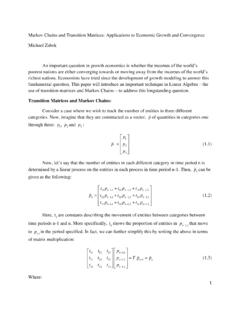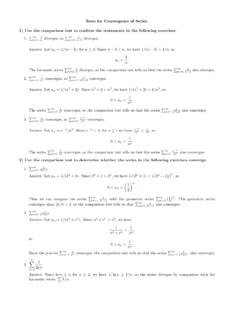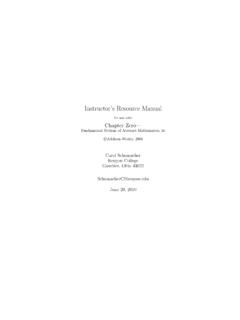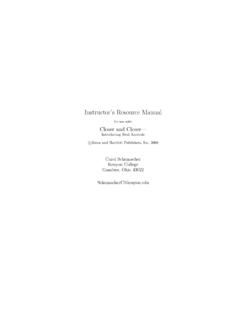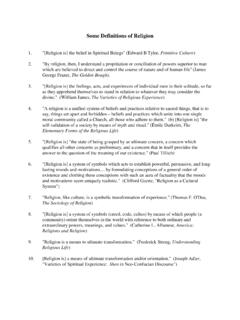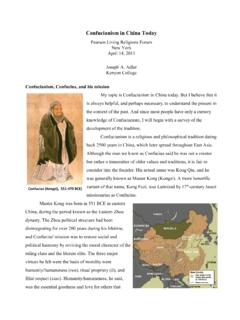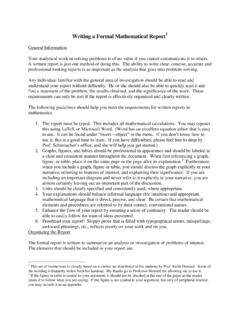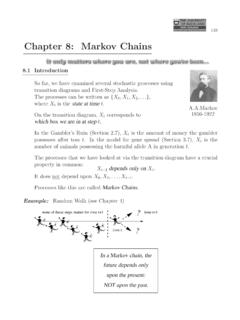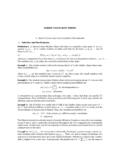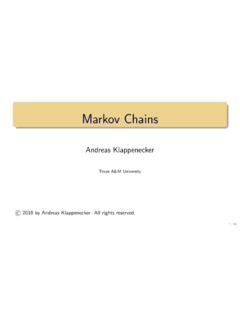Transcription of Linear Algebra Application~ Markov Chains
1 LinearAlgebraApplication~ wayofdealingwitha sequenceofeventsbasedontheprobabilitiesd ictatingthemotionofapopulationamongvario usstates(Fraleigh105).Considera situationwherea a scciesofdisccctetimeinte,vaisove,whicha populationdistributionata giventime(t=n;n=0,1,2,..) canbecalculatedbasedonthethedistribution atanearliertime(t=n-l) ,a (Fraleigh105) givenstatecanneverbecomenegativeIfitiskn ownhowapopulationwillredistributeitselfa ftera giventimeinterval, ,calleda tcansit~atrix,descdbesthepwbabilistiemot ionofa populationmovestoa (thatis,thetotalpopulationisunchanging)a ndtherearenonegativeentries(logically,po pulationsarepositivequantities). ,denotedtij, (1)populationmovesfromstate3 ,the3 x3 matrixaboverepresentstransitionprobabili tiesbetween3 ,t23forexample,describesthelikelihoodtha ta~oftheIYl1m~Havinga meanstodescribethechangesina populationdistribution, columnvectorp=PIP2Pn/(2)AnelementPiofsuc ha vector,knownasapopulationdistributionvec tor,providesthee transitionmatrix,thesumoftheentriesinpmu staddto1 transitionmatrixtoa populationvectorprovidesthepopulationdis -tributionata , ,whentheoriginalmatrixTisraisedtosomepow erm, matrixiscalledaregularchain(Fraleigh107) .
2 Forsucha matrix,thepopulationswilleventuallyappro acha ;ratherthatitisina stateofdynamicequilibriumsuchthatthenetm ovementintoandoutofa (3)ThevectorsinEquation3 (T-1)s=0 Thelastlineisjustahomogeneouslinearequat ionwhichcanbesolvedeasilybya rowreductionontheaugmentedmatrix[T-110]. /Anotherpropertyofregulartransitionmatri cesisthatasm---t00 Inwords,asTisraisedtohigherandhigherpowe rs,thecolumnvectorsofTmapproachthesteady -statevectors (Fraleigh108).Fora matrixQcomprisedofthesteady-statevectora s4itscolumnvectors(Anton614):82 82 QxX282=(1)8=8(5)Thisresultispreciselywha twewouldexpect, ,werelyontherequirementthatthesumoftheen triesofa ,fora steady-statetransitionmatrix(Q=Tffiasm-> 00), ,aregulartransitionmatrixTisshowntohavee igenvector8 with0genValUeA= ,it canbeshownthatanytransitionmatrixobeying conditions1 and2 musthaveA=1 ,webeginwithannxntransitionmatrixwhosech aracteristicpolynomialdet(T-AI)canbeshow ninmatrixform5(6)Recallcondition1 fora transitionmatrix:thesumoftheentriesofa >.
3 =1 exactlyoncefromeachcolumn(asisdoneabovei nEquation6)resultsina ,performrowoperationsbyaddingeachrow(2th roughn)tothefirstrow(Williams):(7)Forcla rity,the(-1)isrepeatedineachoftherow1ele ments,butthissimplyreflectsthatT-(1) (Fraleigh258).Sincethesummationsofelemen tsineachcolumnarerequiredtoaddto1,and1 isalsobeingsubtractedfromeachsum, ,becausethedeterminantofa matrixcanb7lculatedbyexpansionbyminorson anycolumnorrowofthematrix,wearefreeto~ho oseexpansionacrossthetoprow,whichclearly resultsina determinantofzero(Fraleigh254).Assuch,>. =1 isa ,includingbiology,chemistry,economics,an dphysics(Lay288).AsanexampleofMarkovchai napplication, (D),Re-publican(R),andIndependent(I) ,thevotingpopulationp=[D,R,I]obeysthered istributionshowninFigure1.~~ ,RepublicanvoteFigure1:Votershiftbetween twoelections(Lay290).Forexample,inanupco mingelection,ofthosethatvotedRepublicani nthepreviouselection,80%willremainRepubl ican,10%willvoteDemocrat,andtheremaining 10% (8) portionofthevotingpopulation, ,rowIweseethat10%ofthose7(9)whopreviousl yvotedRepublicanwillvoteIndependent(inag reementwithFigure1).
4 Inthe2004presidentialelection,thevotersw eredistributedaccordingtothedistribution vector( )A8PI= ,wecanexpecttheoutcomeofthe2008electiona sfollows:. (10)fvloreexplicitly,70%oftheoriginalDem ocrats(48%)remainDemocrat,10%ofthe51%Rep ublicanpopulationwillvoteDemocrat,and30% ofthe1%LibertarianpopulationalsovoteDemo crat:.70(.48)+.10(.51)+.30(.01)=.336+.05 1+.003=.390(11)Thesamegoesfortheshiftofv otestotheRepublicanandLibertarianparties (Lay291).Ifthisvoterbehaviorisvalidfora longtime, ,itcanbeshownthatsincethetransitionmatri xhereisobviouslyregular(T1hasnozeroentri es),a [T-liD], 010-9/40[T-110]= therefore,hascompo-nentsXl=9/4,X2=15/4,X 3= validpopulationvector(withthesumoftheent riesequalto1), ~ thereforedemonstratesthatthevotingpopula tionwilleventuallysettleintoastateinwhic h54%ofthevoteswillbecastfortheRepublican candidate(Lay295).Furtherinsightintostea dy-statesolutionscanbegatheredbyconsider ingMarkovchainsfroma ,[ ]T-(12) ,thetransitionmatrixdemonstratesthateach year,97%ofthecity-dwellersremaininthecit ywhile5% ,97%ofthesuburbanitesremainwhile3% ,weperformeigenvalueandeigenvectoranalys isbysolvingthecharacteristicpoly-nomiald et(T-).
5 I)= ).. )"+.92= ,)..1=1 and)..2= (T-)..I)x=0,theeigenvectorsarecalculated .(13)Anyarbitrarypopulationdistributionv ectorpcanbewrittenintermsofVIandV2'(14)W eusea Markovchaintosolveforlaterpopulationdist ributions,andwritetheresultsintermsofthe eigenvectors:Observingthepattern,weseeth atingeneral,Asn-t00,thesecondtermdisappe ars,andPnapproachesa steady-statevectors=CIVI(Lay316).Ofcours e,thisvectorcorrespondstotheeigenvalue). .=1,whichisindicativeofa ,thatonlytheimme-diatehistoryaffectsthen extoutcome, caseinpoint- itisunlikelythatthevotingpopulationwilla pproacha ,themodelaffordsuswithgoodinsightandperh aps/servesasa , , , , , , , , , , ,NY:AcademicPress, , , ,'on,MA,AllynandBacon.
